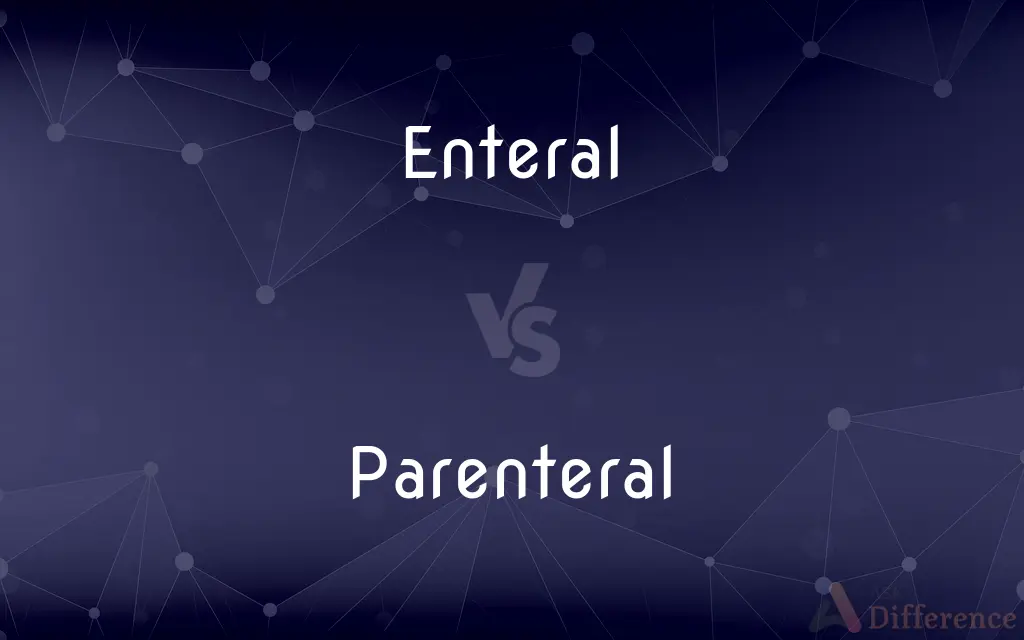Enteral vs. Parenteral — What's the Difference?
By Tayyaba Rehman & Fiza Rafique — Updated on April 15, 2024
Enteral nutrition involves feeding through the gastrointestinal tract, whereas parenteral nutrition bypasses it, delivering nutrients directly into the bloodstream.

Difference Between Enteral and Parenteral
Table of Contents
ADVERTISEMENT
Key Differences
Enteral nutrition is administered via the gastrointestinal tract, using tubes that deliver nutrients directly to the stomach or small intestine. This method is preferred when the digestive system is functional but the patient cannot eat normally. Parenteral nutrition, on the other hand, is delivered intravenously, bypassing the gastrointestinal tract entirely. This method is used when the digestive system needs to be bypassed due to dysfunction or surgery.
Enteral feeding supports the natural function of the gastrointestinal tract and promotes better absorption of nutrients, as the body processes them in the natural way. Parenteral nutrition, whereas, is necessary when the GI tract is not working properly, but it risks complications like infections and does not support gut integrity.
The composition of enteral nutrition typically mimics a balanced diet and may include proteins, carbohydrates, fats, vitamins, and minerals, adjusted to patient needs. In contrast, parenteral solutions are more complex and tailor-made for each patient's specific metabolic demands and are administered directly into the bloodstream.
Enteral nutrition is generally safer, less expensive, and associated with fewer complications than parenteral nutrition. Whereas parenteral feeding is more invasive and requires careful monitoring of blood levels to prevent imbalances and complications.
The choice between enteral and parenteral nutrition depends on the patient's medical condition, ability to digest and absorb nutrients, and the anticipated duration of feeding. Enteral is usually preferred if the GI tract is functional, while parenteral is opted for when the GI tract is non-functional or needs rest.
ADVERTISEMENT
Comparison Chart
Route of Administration
Through the GI tract (oral, tube feeding)
Directly into the bloodstream (IV)
Utilization
Utilizes the digestive system
Bypasses the digestive system
Risk
Lower risk of complications
Higher risk of complications (e.g., infections)
Cost
Generally less expensive
More expensive due to complex formulation and administration
Indication
Functional GI tract
Non-functional or resting GI tract
Compare with Definitions
Enteral
Enteral nutrition involves feeding through tubes placed directly into the stomach or intestines.
After his surgery, John was put on enteral nutrition to ensure adequate nutrient intake.
Parenteral
This method requires precise nutrient balancing to avoid metabolic issues.
The clinic carefully monitored Jane's blood for any imbalances during her parenteral nutrition regimen.
Enteral
It is often used when patients can digest but cannot eat by mouth.
Enteral feeding was chosen for Lisa since she could digest food but had difficulty swallowing.
Parenteral
It bypasses the gastrointestinal tract entirely, used during GI tract dysfunctions.
When Dave’s GI tract needed to rest post-surgery, parenteral feeding was initiated.
Enteral
Enteral solutions may vary from liquids to semi-solid forms, tailored to patient needs.
The hospital customized a semi-solid enteral diet for Emma to improve her nutrient absorption.
Parenteral
Parenteral nutrition involves delivering nutrients directly into the bloodstream through IV.
Parenteral nutrition was necessary for Alice who had severe bowel inflammation.
Enteral
It's generally associated with fewer complications like infections or metabolic imbalances.
To avoid potential infections from IV feeding, enteral nutrition was administered.
Parenteral
Despite its complexity, it's crucial for patients who cannot utilize their GI tract.
Parenteral nutrition supported Eva’s nutritional needs when her Crohn’s disease was at its worst.
Enteral
This method supports gut health and immunity by using the natural digestive pathway.
The doctors preferred enteral nutrition to maintain Michael's gut function during his recovery.
Parenteral
Parenteral solutions are sterile and require meticulous handling to prevent infections.
Sterile techniques were crucial while preparing Mike’s parenteral nutrition bags.
Enteral
Of, relating to, or being within the intestine.
Parenteral
(Physiology) Located outside the digestive tract.
Enteral
Of, pertaining to, within, or by way of the intestine; enteric.
Parenteral
(Medicine) Taken into the body or administered in a manner other than through the digestive tract, as by intravenous or intramuscular injection.
Enteral
Of or relating to the enteron
Parenteral
(medicine) Administered by some means that avoids the gastrointestinal tract, particularly intravenously or by injection.
Enteral
Of or relating to or inside the intestines;
Intestinal disease
Parenteral
Administered by means other than through the alimentary tract (as by intramuscular or intravenous injection)
Parenteral
Located outside the alimentary tract
Common Curiosities
What is enteral nutrition?
Enteral nutrition is a method of feeding that uses the gastrointestinal tract, either through normal eating or by tube feeding.
What is parenteral nutrition?
Parenteral nutrition refers to delivering nutrients directly into the bloodstream, bypassing the gastrointestinal tract.
How are nutrients delivered in enteral nutrition?
Nutrients are delivered directly to the stomach or intestines via tubes.
What are the risks of parenteral nutrition?
Risks include infections, particularly at the catheter insertion site, and metabolic imbalances due to direct bloodstream feeding.
When is enteral nutrition preferred over parenteral?
Enteral nutrition is preferred when the GI tract is functional and the patient needs nutritional support they cannot achieve through normal eating.
How does enteral feeding promote gut health?
By utilizing the digestive system, it helps maintain the health and function of the GI tract.
What conditions might require parenteral nutrition?
Conditions that impair the absorption or digestion of food, like severe inflammatory bowel diseases or after extensive bowel surgery.
What monitoring is required for parenteral nutrition?
Close monitoring of blood nutrient levels, electrolyte balance, and signs of infection is necessary.
How long can a person be on enteral nutrition?
Depending on the condition, patients can be on enteral nutrition for short periods or indefinitely if necessary.
Can enteral nutrition support immune health?
Yes, because it maintains gut integrity and function, which is crucial for immune health.
Are there different types of enteral feeding methods?
Yes, including nasogastric, gastrostomy, and jejunostomy feeding, depending on the access point to the GI tract.
Can a patient switch from parenteral to enteral nutrition?
Yes, if the patient’s condition improves and the GI tract becomes functional, transitioning to enteral nutrition is possible.
Is parenteral nutrition more expensive than enteral nutrition?
Yes, due to the need for specialized solutions and more intensive monitoring.
What factors influence the choice between enteral and parenteral nutrition?
Factors include the functional status of the GI tract, the patient’s overall health, and specific nutritional needs.
What are the benefits of parenteral nutrition?
It provides nutritional support when the GI tract cannot be used, ensuring that nutritional needs are met.
Share Your Discovery

Previous Comparison
Break vs. Crack
Next Comparison
Quicksand vs. MudAuthor Spotlight
Written by
Tayyaba RehmanTayyaba Rehman is a distinguished writer, currently serving as a primary contributor to askdifference.com. As a researcher in semantics and etymology, Tayyaba's passion for the complexity of languages and their distinctions has found a perfect home on the platform. Tayyaba delves into the intricacies of language, distinguishing between commonly confused words and phrases, thereby providing clarity for readers worldwide.
Co-written by
Fiza RafiqueFiza Rafique is a skilled content writer at AskDifference.com, where she meticulously refines and enhances written pieces. Drawing from her vast editorial expertise, Fiza ensures clarity, accuracy, and precision in every article. Passionate about language, she continually seeks to elevate the quality of content for readers worldwide.














































